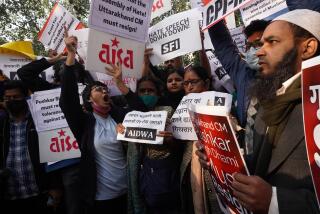Few Women Survive in India Villages After Being Branded as Witches
- Share via
KARANDIH, India — Waving swords in the dark, 10 frenzied men battered at the frail wooden door of Manikui Goipai’s mud and thatch house while she trembled on her bed and her family tried to keep the attackers out.
“Kill the witch!” they screamed.
Hours earlier, a villager had died of tuberculosis. But in a land where people grow up on superstition, rumors quickly spread that a woman had caused the death through witchcraft. The village ojha, or exorcist, declared it was Goipai.
The assailants broke open the door and hacked Goipai’s husband to death as she screamed in terror. They sliced through her son’s arm, but he escaped and was able to summon police before bleeding to death.
A sword came down on Goipai’s forehead, causing a grievous wound. She stopped the second blow with her hand, suffering a deep gash. Then the attackers fled, trying to escape arriving police officers. They were arrested within hours.
“They should die inside the jail,” said Goipai, now 40, her bitterness undiminished by the five years since the attack. She lives alone on the outskirts of Karandih, where she has been visited only by reporters since then.
Goipai is one of only a few women to survive an attack after being branded a witch in Bihar, India’s most lawless state.
According to the Free Legal Aid Committee, which seeks punishment for such attacks, 536 women have been slain in the last 10 years in just two districts of Bihar, India’s witch-killing hub. Unofficial estimates say at least 200 women are killed as witches across India each year.
But many cases go unreported in remote areas of Bihar, an eastern state where the Ho and Santhal tribes live. These clans lived for centuries in deep forests, surviving on its produce and taking little from the outside world. They hunt with bows, worship nature and swear loyalty to the village headman.
Women accused of witchcraft are dragged into the forest and hacked, hanged or burned to death. Heads of children have been smashed on rocks. Even nonfatal cases are ghastly. Women suffer smashed teeth, shaved heads or chopped-off breasts. Others have been forced to eat excrement or to strip and walk naked through villages.
The Bihar government passed a tough law last year requiring a three-month prison sentence for even calling a woman a witch. Killers of women in witch cases face the death penalty.
But convictions are rare.
“It is difficult to investigate who gave the fatal blow,” said District Collector Nidhi Khare, administrator of the East Singhbhum district.
“There will be no witness, and most accused get bail and are set free,” she said. “It’s a day-to-day battle for these women.”
In many cases, killers are related to victims, attacking out of fear of a witch’s supposed powers and the possibility of social rebuke for having a witch in the family.
“Those who kill do not think they are committing any crime,” said Girija Shankar Jaiswal, a lawyer who argues cases for victimized women. “They think they are becoming martyrs. They do not mind going to jail.”
That could explain why in the village of Damaria, a young man killed his aunt in July, chopped off her head and took it to a police station in a sack to confess he had killed a witch.
Those who kill women they believe are witches don’t look for proof, said Ajitha George, who is doing research on witch killings for the Chicago-based MacArthur Foundation.
Most witch killings have their roots in sickness or death.
In Bihar state, where only 52% of the men and 23% of the women are literate, there is only one primary care center for every 100,000 people. So the village exorcist doubles as a doctor.
“Traditionally ojhas used to give medicine using herbal potions, but now the tribal health system is falling apart,” George said. “Now there are many new diseases, and they don’t know the cure.”
So they use women as scapegoats, she said.
Development in the mineral-rich region around the Swarnarekha River also is a factor, George said.
“Now there is alienation, deforestation, the whole fabric is breaking up,” she said. “Landholdings have shrunk, and in many cases people bribe witch doctors to target widows or single women who own land.”
Chhutni Mahatani, 40, has become a heroine to victims by fighting back.
She was forced to eat excrement by her own brother-in-law five years ago after a child fell ill in her village. She also was expelled from the village and rejected by her husband.
Mahatani sued her relatives for branding her a witch. A judge found them guilty but let them off, saying it was their first offense. Mahatani is appealing.
Over the years, she built a house a few miles from her home village, reared her children and married off the eldest son in June. No relatives were invited to the wedding.
“Everybody is our enemy,” she said, her eyes moist.
More to Read
Sign up for Essential California
The most important California stories and recommendations in your inbox every morning.
You may occasionally receive promotional content from the Los Angeles Times.













